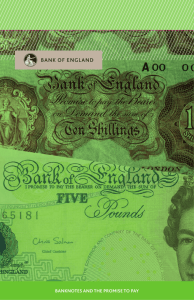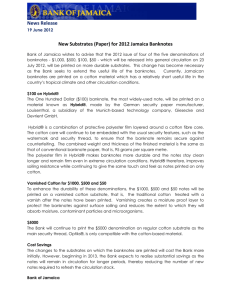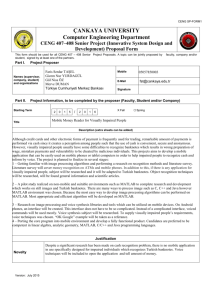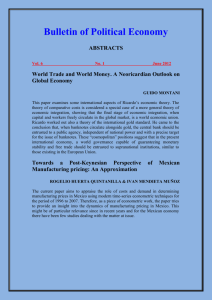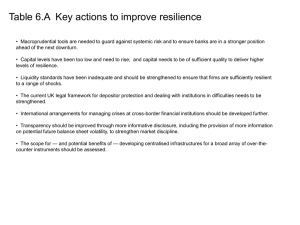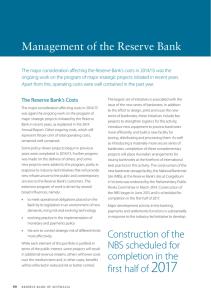Currency
advertisement
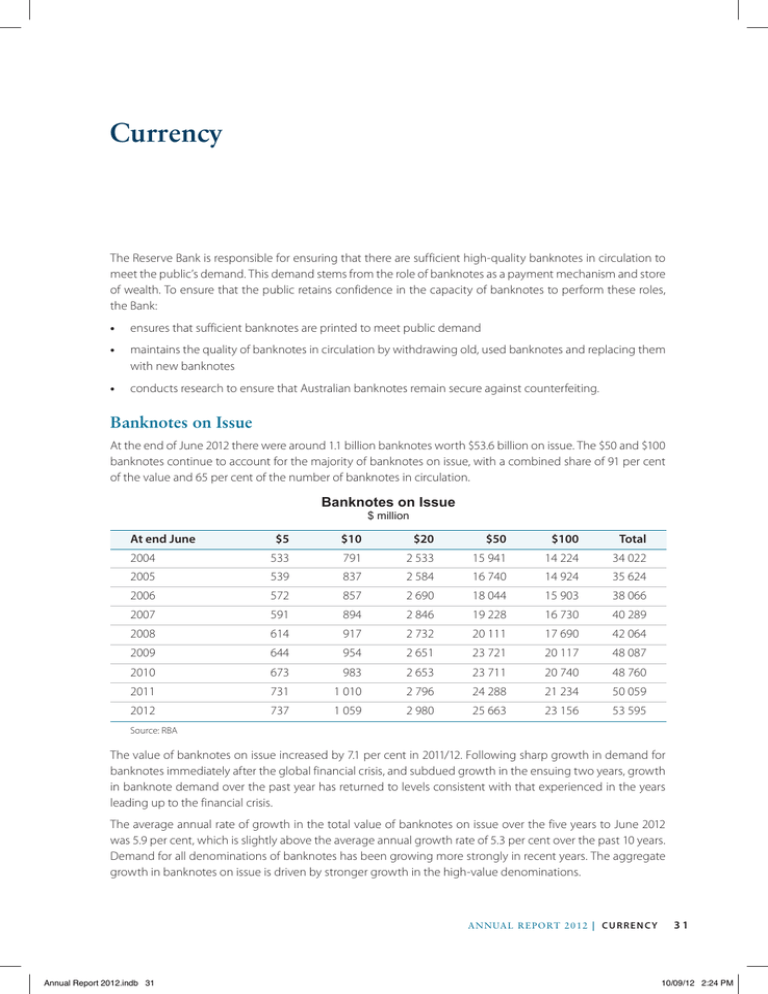
Currency The Reserve Bank is responsible for ensuring that there are sufficient high-quality banknotes in circulation to meet the public’s demand. This demand stems from the role of banknotes as a payment mechanism and store of wealth. To ensure that the public retains confidence in the capacity of banknotes to perform these roles, the Bank: •• ensures that sufficient banknotes are printed to meet public demand •• maintains the quality of banknotes in circulation by withdrawing old, used banknotes and replacing them with new banknotes •• conducts research to ensure that Australian banknotes remain secure against counterfeiting. Banknotes on Issue At the end of June 2012 there were around 1.1 billion banknotes worth $53.6 billion on issue. The $50 and $100 banknotes continue to account for the majority of banknotes on issue, with a combined share of 91 per cent of the value and 65 per cent of the number of banknotes in circulation. Banknotes on Issue $ million At end June $5 $10 $20 $50 $100 Total 2004 533 791 2 533 15 941 14 224 34 022 2005 539 837 2 584 16 740 14 924 35 624 2006 572 857 2 690 18 044 15 903 38 066 2007 591 894 2 846 19 228 16 730 40 289 2008 614 917 2 732 20 111 17 690 42 064 2009 644 954 2 651 23 721 20 117 48 087 2010 673 983 2 653 23 711 20 740 48 760 2011 731 1 010 2 796 24 288 21 234 50 059 2012 737 1 059 2 980 25 663 23 156 53 595 Source: RBA The value of banknotes on issue increased by 7.1 per cent in 2011/12. Following sharp growth in demand for banknotes immediately after the global financial crisis, and subdued growth in the ensuing two years, growth in banknote demand over the past year has returned to levels consistent with that experienced in the years leading up to the financial crisis. The average annual rate of growth in the total value of banknotes on issue over the five years to June 2012 was 5.9 per cent, which is slightly above the average annual growth rate of 5.3 per cent over the past 10 years. Demand for all denominations of banknotes has been growing more strongly in recent years. The aggregate growth in banknotes on issue is driven by stronger growth in the high-value denominations. AN N UAL R E P O RT 2 0 1 2 | C u r r e n c y Annual Report 2012.indb 31 31 10/09/12 2:24 PM Banknotes in Circulation Banknotes in Circulation* Average annual growth Year-to-date percentage change % % % 6 2011/12 10 % n 2002–2012 n 2007–2012 6 5 5 4 4 3 3 2 2 1 1 10 5 5 0 l J l A l S l O l N l D l J l F l M l A 0 l M 0 New Banknote Purchases Distribution l $10 l $20 0 l $50 $100 Total Source: RBA * Shaded area represents the range for the four years ended June 2008 Source: RBA The Reserve Bank purchased 129 million banknotes from Note Printing Australia Limited (NPA) in 2011/12, 19 million fewer banknotes than in 2010/11. The Bank’s purchases consisted of 29 million $5 banknotes, 29 million $10 banknotes, 40 million $50 banknotes and 31 million $100 banknotes. No $20 banknotes were purchased. l $5 J Banknote Purchases M M 250 250 200 Average 200 150 150 100 100 50 50 The Reserve Bank maintains a contingency holding 0 0 96/97 99/00 02/03 05/06 08/09 11/12 of banknotes to meet seasonal fluctuations in Source: RBA demand, and to mitigate the risks associated with systemic shocks and production disruptions. The Reserve Bank and the major commercial banks have established arrangements to ensure that the commercial banks can access these banknotes to meet their customer needs. The commercial banks also have large banknote holdings at cash-in-transit company depots and their branches throughout the country to ensure there is sufficient stock to meet normal and unexpected demand. As noted above, demand for banknotes has typically grown at around 5–6 per cent per year. However, the pattern of growth within each year is highly seasonal. The major commercial banks can purchase banknotes from the Reserve Bank throughout the year but, in general, the majority are purchased during the months leading up to Christmas and Easter. In January and after Easter, the commercial banks sell banknotes back to the Reserve Bank that are deemed fit for circulation but surplus to their requirements. In addition, throughout the year the commercial banks return to the Reserve Bank banknotes that they deem are not suitable for circulation (see below). Over 2011/12, the Reserve Bank issued 243 million banknotes to the major commercial banks, of which 121 million had previously been in circulation and 122 million were new. On the other side, the Bank received about 182 million banknotes from the commercial banks in 2011/12, including 93 million surplus fit banknotes and 89 million banknotes deemed no longer fit for circulation. 32 R es e rv e ba n k o f Aus tr a l i a Annual Report 2012.indb 32 10/09/12 2:24 PM Banknote Quality The Reserve Bank aims to maintain a high quality of banknotes in circulation in order to ensure they meet the functional requirements of the public, and to make it more difficult for counterfeits to be passed or remain in circulation. Achieving these objectives is important to maintaining public confidence in Australia’s banknotes. The commercial banks and cash-in-transit companies play an important role in achieving the Reserve Bank’s quality objectives. For this reason, the Reserve Bank provides incentives for the major banks and cash-in-transit companies to remove unfit banknotes from circulation. These arrangements enable cash industry participants to invest in banknote processing equipment, which enhances their ability to sort banknotes and remove poor-quality banknotes from circulation. Banknotes that are determined to be unfit by the commercial banks and cash-in-transit companies are returned to the Reserve Bank’s National Note Processing and Distribution Centre (NNPDC), where their authenticity and quality is confirmed. Banknotes that are confirmed as being unfit are destroyed and fit banknotes are packaged for reissue. Of the banknotes returned to the NNPDC and processed during 2011/12, 88.9 million were deemed unfit and destroyed. Periodically, banknotes are damaged in circulation beyond the normal levels of wear and tear. The Reserve Bank’s policy is to pay value for severely damaged banknotes that can be verified as being genuine. This includes banknotes that are damaged or contaminated as a result of natural disasters. Most damaged banknotes receive full value, but where a large piece of a banknote is missing, partial value is paid. All damaged and contaminated banknotes are returned to the Reserve Bank for validation, assessment and destruction. In 2011/12, the Reserve Bank processed around 16 900 damaged banknote claims and paid out $6.1 million. This represents a significant decline from the $11.6 million in claims paid in 2010/11, which was boosted by a large number of high-value claims resulting from natural disasters in that year. Counterfeiting in Australia In 2011/12, a total of 7 781 counterfeits were detected in circulation with a nominal value of $410 795. This corresponds to around 6.9 counterfeits detected per million genuine banknotes in circulation, a level that is low by international standards. The level of counterfeiting declined substantially from the previous year, following the arrests in November 2010 of several persons allegedly associated with a well-organised criminal operation in New South Wales. The number of counterfeits detected has now returned to levels consistent with previous experience. Counterfeits Detected Parts per million genuine banknotes ppm ppm 15 15 10 10 5 5 0 0 03/04 05/06 07/08 09/10 11/12 Source: RBA The Reserve Bank works closely with law enforcement agencies to monitor trends in counterfeiting and identify emerging threats. The Bank’s Counterfeit Examination Laboratory also assists police by providing counterfeit examination services and preparing expert witness statements and court testimonies. AN N UAL R E P O RT 2 0 1 2 | C u r r e n c y Annual Report 2012.indb 33 33 10/09/12 2:24 PM Counterfeit Banknotes in Australia 2011/12 Number $5 $10 $20 $50 $100 Total 13 56 186 6 923 603 7 781 Nominal value ($) 65 560 3 720 346 150 60 300 410 795 Parts per million 0.1 0.5 1.3 13.6 2.7 6.9 Source: RBA Community Liaison The Reserve Bank is actively involved in a number of banknote awareness initiatives involving law enforcement agencies and the community. During the year, counterfeit information sessions were conducted with state police in New South Wales, South Australia and the Northern Territory. Presentations have also been conducted for business, school and community groups with the aim of increasing knowledge about banknotes in the community. Banknote Research and Development The Reserve Bank conducts a research and development program that examines innovative technologies and develops features that can enhance the security of polymer banknotes. As part of this program, the Bank collaborates with a range of third parties, including private companies, research institutions and universities. The Reserve Bank also cooperates with other central banks to explore issues and develop research programs regarding counterfeit deterrence. In 2011/12, the Reserve Bank continued its involvement in two major international initiatives related to the combat of counterfeiting: the Central Bank Counterfeit Deterrence Group, a working group of central banks and banknote printing authorities that monitors and responds to threats posed by emerging counterfeiting technologies; and the Reproduction Research Centre, an anti-counterfeiting testing facility operated by a small group of central banks. Numismatic Banknote Sales The Reserve Bank conducted numismatic banknote sales in July and August 2012 for all denominations of banknotes produced in 2011. These banknotes were sold to the public at fixed prices during a six-week sale period. Note Printing Australia Note Printing Australia Limited (NPA) is a wholly owned subsidiary of the Reserve Bank that produces banknotes and operates the NNPDC on behalf of the Bank. NPA operates under a charter established by the Reserve Bank Board. Specifically, NPA’s prime function is the efficient and cost-effective production of Australian banknotes of high quality and security, in accordance with the specifications and requirements of the Bank. The charter also permits NPA to undertake other ‘non-core’ activities, including the development and production of passports for the Department of Foreign Affairs and Trade (DFAT), as well as the production of banknotes for other issuing authorities and some other security products. In recent years, these activities have included the production of banknotes for some countries in the Asia-Pacific region. In all of these cases, NPA dealt directly with the relevant central banks. 34 R es e rv e ba n k o f Aus tr a l i a Annual Report 2012.indb 34 10/09/12 2:24 PM NPA is governed by a Board of Directors appointed by the Reserve Bank. As at 30 June 2012, the Board comprised five Bank executives: Michele Bullock, Assistant Governor (Currency) as Chair; Keith Hall, Assistant Governor (Banking and Payments); Darryl Ross, Chief Financial Officer; Lindsay Boulton, Head of Banking Department; and Michelle McPhee, Head of Risk Management. The Chief Executive Officer of NPA is Bernhard Imbach. In 2011/12, NPA delivered 129.1 million banknotes for Australia and 139.3 million banknotes to other countries, including Chile, Brunei and Papua New Guinea. NPA also produced 1.8 million passports for DFAT over the year. NPA recorded a loss after tax of $1.9 million in 2011/12, compared with a profit of $4.4 million in 2010/11. The financial accounts of NPA are consolidated with those of the Reserve Bank. Securency Securency International Pty Ltd manufactures polymer substrate for banknotes used in Australia and many other countries. It is a joint venture between the Reserve Bank and Innovia Films, a UK-based company that makes the base polymer film used by Securency to manufacture its substrate products. Securency is governed by a Board of Directors, comprising equal numbers of directors appointed by the two joint-venture partners and the Managing Director. At present, the Reserve Bank appointed directors are Darryl Ross (Chairman) and John Akehurst, a non-executive member of the Reserve Bank Board. In late 2010 the Reserve Bank and Innovia Films announced their intention to undertake a joint sale of the company. This joint process was terminated late in 2011, after Innovia advised the Bank that it was no longer a seller. The Bank continues to explore divestment of its interest in Securency. Proceedings against NPA and Securency As noted in the 2011 Annual Report, NPA and Securency were charged in July and August 2011 with conspiring to bribe public officials in a number of countries during the period between 1999 and 2004. Additional charges were laid against NPA in September 2011. A number of former employees of NPA and Securency, including a former Chief Executive of each of these companies, were also charged. Over 2011/12, NPA and Securency continued to cooperate with the Australian Federal Police and the Commonwealth Director of Public Prosecutions. AN N UAL R E P O RT 2 0 1 2 | C u r r e n c y Annual Report 2012.indb 35 35 10/09/12 2:24 PM 36 R es e rv e ba n k o f Aus tr a l i a Annual Report 2012.indb 36 10/09/12 2:24 PM
